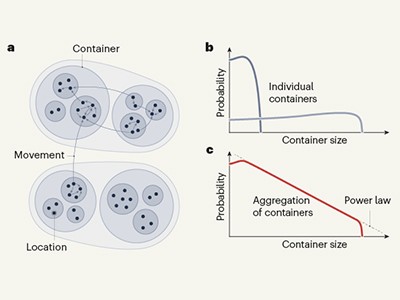As a scientist, you sometimes come across a finding that is clear and robust, revealing a pattern that was right in front of you all along — and which makes you want to kick yourself for not noticing it before. The universal visitation law of human mobility, reported in Nature by Schläpfer et al.1, is just such a finding. The authors uncover a pattern of human behaviour that connects travel distance to the frequency of trips.
Consider any two places. Can we predict how many people travel from one to the other, and vice versa, on the basis of the position and simple characteristics of the two locations? This question is at the core of a large body of literature whose origin dates back to the mid-nineteenth century. In 1885, the geographer Ernst Ravenstein showed empirically that two key elements explain the number of individuals who move between any two places2: the distance between the places, and the socio-economic properties of the origin and destination. The number of travellers tends to decrease with distance, for example, and more-populated places attract more travellers.
These key observations were later integrated into the gravity law of human mobility, which states that the number of travellers between two cities increases with a power of the cities’ population sizes, and decreases with a power of the distance between them3. A refinement of the gravity law, known as the radiation model, proposes that the number of travellers does not depend directly on the distance between two cities, but rather on the number of places between the cities at which people would realistically stop4.
Research into human mobility has flourished in the past few years, as a result of data becoming available with increasingly fine spatial and temporal resolution5. This has allowed researchers to adjust the radiation and gravity models, and a plethora of variations, to capture travel patterns on a range of timescales, including home relocation (residential mobility), airline travel, urban transportation and commuting. Schläpfer and colleagues now report a fundamental discovery in this highly active area of research. They have identified a key component that was missing from existing theoretical frameworks of human mobility: visitation frequency (f), the number of trips that someone makes to a location per unit of time.
The authors made their discovery by reframing the challenge faced by modellers. Instead of focusing solely on distance and sociodemographic features, they asked a further question: ‘How many people living in any given place travel to any other place exactly n times in a period T?’ This change in perspective is possible because mobility data for individuals are now available from mobile-phone tracking. By studying mobility traces extracted from phones at seven urban locations around the world, the authors uncovered a phenomenological law that answers their question: the number decreases with r2 (where r is the distance from someone’s home to a given location), and with f2, where f = n/T (Fig. 1).
Surprisingly, this law is valid for all the widely different urban systems considered in the study, and thus provides a general framework for describing and predicting mobility flows across timescales. Importantly, the model accommodates diverse mobility behaviours, from commuting to residential mobility, without requiring a change of parameters.
To understand how the observed pattern emerges robustly from the multitude of individual behaviours, Schläpfer et al. developed a model of the mobility of individuals that incorporates realistic and well-understood mechanisms, such as people’s tendency to explore places that are popular with other visitors, and preferential return — an empirical phenomenon in which the number of visits received by a location is proportional to the number of visits previously received6. This model reproduces the collective patterns of mobility observed in the phone data. By linking the mobility of individuals to collective outcomes, the authors’ work helps to narrow the gap between two streams of literature that have previously been broadly distinct5. The findings therefore pave the way for studies that could deepen our theoretical understanding of how individual and collective mobility patterns are connected.
One unanswered question is whether the patterns of mobility observed in urban areas also apply outside cities. The geographies of rural areas are less centralized and contain fewer places of interest to visitors than do urban areas; these characteristics might result in travel patterns different from those observed by Schläpfer and colleagues. Another key question is whether mobility patterns are different for trips that are not anchored to people’s homes.
In their modelling of travel patterns, the authors assume that people head straight home after visiting any location. But in the real world, geographical considerations and the need to minimize travel time tend to result in trips in specific reccurring sequences. People often visit places in a certain order, for example going from work to the supermarket and gym, and then home. We therefore anticipate that models that capture the ordering of trips will be key to providing a truly comprehensive description of collective mobility flows across space and time, and even more accurate predictions of real-world behaviour. In the meantime, we expect the mobility patterns uncovered by Schläpfer et al. to be useful for a variety of purposes, from epidemic modelling to transportation planning and urban design.
Trip frequency is key ingredient in new law of human travel - Nature.com
Read More




No comments:
Post a Comment